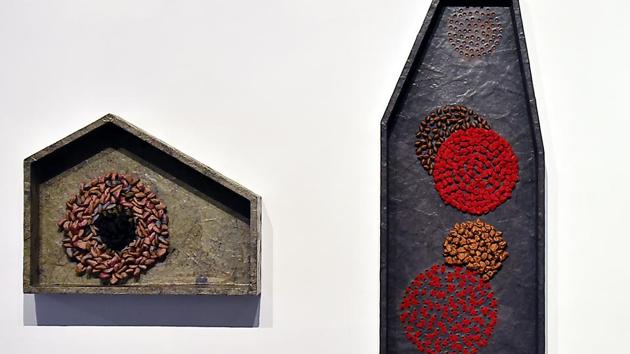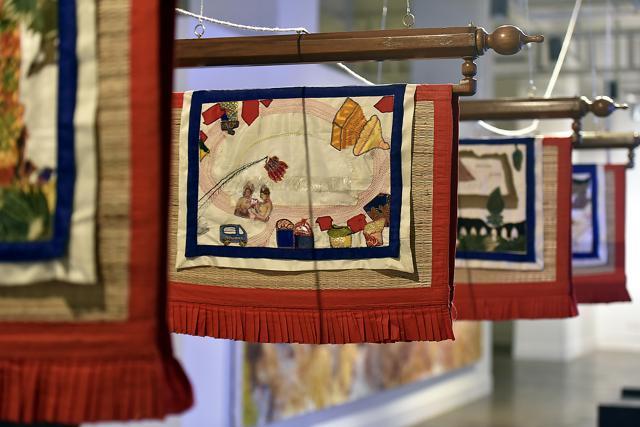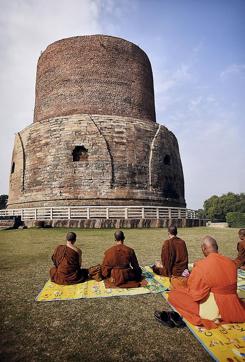Secular and sacred: A tale of two cities
An ongoing exhibition in Delhi reflects on the past and present of two ancient, holy cities that have been sites of faith and conflict.
On her first visit to Anuradhapura in Sri Lanka, artist Manisha Parekh was struck by the size of the stupas that dotted the sacred city. Gigantic white domes spread against the blue skies inspired a certain awe that when mixed with the serenity of the pilgrimage site was simply overwhelming.

“I felt like a midget in front of the stupas,” she says. “There is a certain calm attached to Anuradhapura and the other sacred sites we visited there such as Dambulla,” says the Delhi-based artist of her research trip — part of an art project involving 11 artists from India and Sri Lanka. The impression the visit left is visible in her works, which interpret the sacred as a private space and are on display at an ongoing exhibition, titled ‘A Tale of Two Cities’, in the capital.
“My work has that blue of the sky and the white of the stupa,” says Parekh of her abstract watercolour series titled ‘A Chant’. Varanasi, the second city the artists visited, is for Parekh the complete opposite in terms of character. “It is bustling with activity. In just one boat ride from one end of the ghats to the other, you’ll see rituals involving birth, death and everything in between,” she says. Her second series titled ‘Home Shrine’ reflects that robust colour and energy.
Read more: After the tigers are gone in Jaffna

Kolkata-based artist Paula Sengupta associates a similar seamlessness of the different rhythms of life with Varanasi. “That same seamlessness exists in the textiles of Varanasi where centuries of weavers, craftsmen, embroiders have come in from different places not only across India but as far as China and Tibet,” she says.
Her interest in and exposure to the textiles of Varanasi made her choose the medium of textile and embroidery to map her extensive travels to Buddhist shrines over the past 12 years. Each of the eight panels on her installation of four grass-mat and cotton-cloth colonial-style pankhas depicts a Buddhist sacred site. The sites depicted include not just Anuradhapura and Sarnath but places as far as Rumtek Monastery in Gangtok, Tabo Monastery in Spiti, the Stupa of Boudhanath in Kathmandu, and the ruins of Nalanda in Bihar, among others.
Sengupta also weaves in the conflicted histories of some sites: figures in military fatigues holding guns co-exist with sacred imagery and structures in panels made with embroidery and appliqué on silk. The pankha — a common object in Indian homes in colonial times — was used to “animate” the installation, says Sengupta. “By pulling the pankha, I wanted the viewer to metaphorically be able to travel with me to these sites,” she says.
The year-long project (it began in October 2015 with a visit to Anuradhapura and then to Varanasi and Sarnath) was conceived by Gallery Espace director Renu Modi and supported by the Serendipity Arts Trust and the Theertha Artists Collective from Sri Lanka.
“The artists got to know each other on the first trip. When we met in Varanasi three months later, we were stronger as a collective and ready for more than the introductory sessions. In addition to site visits, we also organised a series of conversations between the artists every day to reflect on our everyday experience of Varanasi,” says Colombo-based Ruhanie Perera, the curatorial advisor of the project.
Parekh agrees. “The interactions made you think of situations differently. You feed off each other’s perspectives and start to see things which you may not have noticed before,” she says.
Read more: Retelling epics for the modern age

Other participating artists include Indian artists Manjunath Kamath, Riyas Komu, Ram Rahman and Chintan Upadhyay and Sri Lankan artists Anoli Perera, Pala Pothupitiye, Pradeep Chandrasiri, Bandu Manamperi and Jagath Weerasinghe.
For Delhi-based photojournalist Ram Rahman, the journeys triggered off connections across time and geographies. In his photo-and-text installation — The Man, The Word, The Tree, The Text — Rahman reproduces excerpts from ancient texts (Buddha’s sermon, meeting the five disciples, the arrival of the Bodhi Tree in Anuradhapura) with photographs from trips to Sarnath and Anuradhapura. These are juxtaposed with video grabs of the LTTE massacre at the sacred Sri Maha Bodhi site in 1985 and newspaper reports on the violence propagated by extremist Sinhalese monks in Sri Lanka, the political appropriation of sacred symbols, and how Buddhist conversions in India (BR Ambedkar and, more recently, the family of Rohit Vemula) became the recourse for those trying to stand up to right-wing ideologies.
“I was interested in looking at what the Buddha had initially propagated and how contemporary politics is distorting religious philosophy, using it for conflict,” says Rahman.
What: A Tale of Two Cities: Traversing Sacred Geographies – Varanasi (India) and Anuradhapura (Sri Lanka)
When: 10 am to 6 pm, until March 31, 2017
Where: Gallery 1, Indira Gandhi National Centre for the Arts, Mansingh Road
Nearest metro station: Central Secretariat
Entry is free





